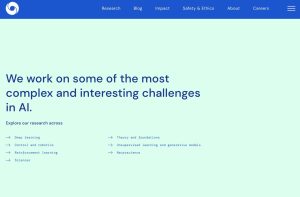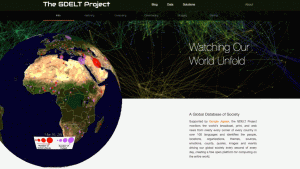How Is AI Changing Our Future of Research?

The world of research is evolving at an incredible pace, and one of the most significant driving forces behind this transformation is Artificial Intelligence (AI). From accelerating drug discovery to predicting climate change, AI is revolutionizing the research landscape in countless ways. Among the most intriguing AI advancements is the development of advanced language models, which have taken the research community by storm. These innovations not only expedite the research process but also enhance its accuracy, opening up new avenues for solving complex societal challenges.
✅Sign up to be notified when a new blogpost is published featuring AI Tools here
Table of Contents
- How Is AI Changing Our Future of Research?
- How Can AI Benefit Society?
- How Do We Use AI For Research in Our Society?
- What is “Research AI”?
- Can AI Do Research?
- How Does AI Research Work?
- When Did AI Research Start?
- Who is Funding AI Research?
- What You Can Do with Chat GPT 4?
How Can AI Benefit Society?
AI’s contribution to society extends beyond research; it’s improving healthcare outcomes, optimizing energy consumption, and making education more accessible. Are you ready to dive into the captivating world of AI-powered research and its myriad benefits to society? Join us as we explore the remarkable capabilities of these cutting-edge language models. This blog post will first illustrate where AI is already being used to benefit society. Afterwards, you will learn how you can use ChatGPT for your research, further contributing to the societal advancements powered by AI.
Did you know that as a researcher, you can get subsidized access to OpenAI?
Researchers working on the societal impact of AI or AI adaptation issues can apply for subsidized access through the “Researcher Access Program”.
Click here to get access: https://openai.com/form/researcher-access-program
How Do We Use AI For Research in Our Society?
The extraordinary potential of Artificial Intelligence (AI) has been making its presence felt across various industries, and research is no exception. With AI’s exceptional ability to handle repetitive tasks, analyze massive datasets, and uncover groundbreaking insights, the research landscape is undergoing a significant transformation. In this article, we will explore three captivating ways AI is revolutionizing the field of research, supported by real-world examples:
1. Speeding up drug discovery with a focus on molecular interactions
Imagine a world where innovative AI-driven platforms, like DeepMind’s AlphaFold, are transforming the drug discovery process at an astonishing pace. These sophisticated tools empower researchers to accurately predict protein structures and their interactions with other molecules. As a result, scientists can identify potential drug candidates more swiftly and cost-effectively than ever before. Picture this: during the COVID-19 pandemic, AlphaFold played an instrumental role in understanding the virus’s proteins, leading to the rapid development of life-saving treatments and vaccines.

For more fascinating details on AlphaFold and its role in accelerating drug discovery, visit DeepMind’s official website (https://deepmind.com/research) and explore their research publication on the AlphaFold system.
2. Unraveling the mysteries of climate change with AI-powered forecasting
Picture AI as a protagonist in the gripping story of climate change research. It helps scientists sift through mountains of data to uncover crucial insights. AI-powered models can project future climate patterns, highlight potential risks, and even suggest transformative mitigation strategies. Consider the Climate Change AI initiative, for instance, which utilizes machine learning algorithms to analyze satellite data, monitor deforestation, and track greenhouse gas emissions. This vital information enables policymakers to make informed decisions in the battle against climate change and the pursuit to protect our planet.

For more information on the Climate Change AI initiative, you can visit their official website (https://www.climatechange.ai/) to explore their ongoing work, research, and collaborations in the field of AI and climate change.
3. Revitalizing social science research with natural language processing expertise
Thanks to AI’s natural language processing (NLP) capabilities, social science research is experiencing a renaissance. Researchers can now delve into vast amounts of text data, revealing hidden patterns and trends. Think of the GDELT Project, which employs NLP techniques to monitor global news coverage and identify emerging social, political, and economic currents. By automating the analysis of millions of news articles, researchers can paint a more vivid picture of worldwide events and their ripple effects on society.
Another prime example is the use of AI-driven sentiment analysis in political science research. By scrutinizing social media posts, researchers can gauge public opinion on various issues, track shifts in sentiment over time, and even forecast election outcomes.

To learn more about the GDELT Project and its use of natural language processing techniques in monitoring global news coverage, you can visit the project’s official website (https://www.gdeltproject.org/).
By the way, in which research area do you work? Click here to vote
I also touch on the importance of staying up-to-date with the latest AI advancements, which is further emphasized in my third blogpost “Attention Researchers and Students: Will AI Replace Your Job? Here’s What You Need to Know.”
What is “Research AI”?
Research AI refers to the application of artificial intelligence (AI) and machine learning techniques to enhance and accelerate scientific research across a wide range of disciplines. By leveraging the immense processing power and pattern recognition capabilities of AI, researchers are able to tackle complex problems and uncover new insights at a pace that would be impossible using traditional manual methods.In the field of healthcare and medicine, AI algorithms can analyze vast troves of medical data, such as patient records, diagnostic images, and clinical trial results, to detect diseases at earlier stages, predict patient outcomes with greater accuracy, and aid in the discovery of new drugs and treatments. Similarly, in climate science, AI is employed to make sense of the massive datasets collected from satellites, weather stations, and climate models, enabling researchers to better understand and predict weather patterns as well as assess the impacts of climate change.The applications of research AI extend to astronomy and astrophysics, where AI tools are used to sift through astronomical data and identify new celestial phenomena, including the detection of exoplanets. In materials science, AI-driven simulations and predictive models have revolutionized the discovery and design of new materials with unique properties, accelerating the pace of innovation in this field.
Can AI Do Research?
Indeed, AI can be used to support different stages of the research process. For example, literature reviews can be greatly accelerated by using AI tools that can quickly analyse large databases of research papers, identify relevant studies and summarise key findings – a task that would be far more time-consuming for human researchers to perform manually. Similarly, AI algorithms can be used to analyse complex datasets, identify patterns and visualise insights that may be difficult for humans to see, potentially leading to new discoveries and hypotheses. AI can also support the academic writing process, with assistants able to draft literature reviews, check for plagiarism and format references, allowing researchers to focus more on analysis and interpretation. In addition, AI-powered peer review platforms can provide constructive feedback on research drafts, similar to human peer review. It is important to note, however, that AI tools are not without limitations. They require large, high-quality datasets to produce accurate and unbiased results, and can potentially inherit biases present in their training data or algorithms. Therefore, human oversight and intervention remain essential to ensure the integrity and validity of research conducted using AI technologies.
How Does AI Research Work?
In academia, AI-powered tools are being developed to assist researchers across a wide range of tasks, from literature search and citation analysis to automated note-taking and summarization. At the core of AI research is the development and optimization of machine learning workflows. This typically involves a cyclical process of data collection, pre-processing, dataset creation, model training and refinement, evaluation, and deployment. Researchers work to continuously improve the performance and capabilities of these AI models, often exploring techniques like hyperparameter optimization and automated feature selection to streamline the research and development process.Beyond just automating tasks, AI research also explores the potential for AI systems to serve as “collaborators” in the research process. These AI tools would be able to provide more context-aware insights by incorporating researcher inputs and background information. However, current AI technologies still face limitations in handling visual data, ensuring proper citation and validation, and mitigating potential biases.
When Did AI Research Start?
The origins of AI research can be traced back to the 1950s. While there were earlier ideas and concepts that can be considered precursors to artificial intelligence, such as the bronze giant Talos from Greek mythology or the considerations of Swiss philosopher Theophrastus Bombastus in the 16th century, the field of AI research was officially founded in the summer of 1956 at a conference at Dartmouth University in the USA. There, scientists like John McCarthy and Marvin Minsky, who would become the leading figures in AI research for the following decades, came together. Computer pioneer Alan Turing had also laid important theoretical foundations for modern computer technology and artificial intelligence in the 1940s with his work on the concept of a “universal Turing machine”. The Dartmouth conference in 1956 thus marked the official starting point for the systematic exploration of the possibilities of developing intelligent machines. In the following decades, AI research would develop into one of the most dynamic and innovative fields of computer science and technology.
Who is Funding AI Research?
The major research funding organizations analyzed in the study are:
- National Natural Science Foundation of China (NNSFC)
- National Science Foundation (NSF) in the United States
- European Research Council (ERC)
- European Commission (EC)
The German Research Foundation (DFG) has launched a strategic funding initiative in the field of artificial intelligence, financing projects across various funding programs from 2020 to 2022. The U.S. National Science Foundation (NSF), in collaboration with other federal agencies, is investing $140 million to establish seven new National Artificial Intelligence Research Institutes. The funding partners include the Department of Commerce’s NIST, Department of Homeland Security, Department of Agriculture, Department of Education, Department of Defense, and IBM. The European Commission is putting €1 billion per year into AI technologies through Horizon Europe and the Digital Europe scheme, with most of the funding concentrated in the cluster dedicated to digital, industry and space transitions. The Defense Advanced Research Projects Agency (DARPA) in the U.S. is requesting increased funding for several key AI research programs in its latest budget, including for autonomous drones, ethical AI systems, and human-machine interaction.
What You Can Do with Chat GPT 4?
Advanced AI language models, like the ones developed by OpenAI, are designed to provide human-like text generation and comprehension. These powerful tools have immense potential for researchers, as they can:

- Assist in literature review by summarizing articles and highlighting key findings
- Generate hypotheses and research questions based on given prompts
- Draft research proposals and grant applications
- Help researchers brainstorm innovative ideas and solutions
- Analyze large datasets and identify patterns or trends
- Facilitate collaboration by generating discussion points or synthesizing input from multiple team members
- Aid in data visualization by generating descriptive text or captions for charts and graphs
- Provide natural language summaries of complex statistical results
- Conduct sentiment analysis on social media data or other text sources for social science research
- Translate research findings or other documents across different languages
- Offer personalized learning materials and resources for students or other researchers in the field
- Enhance the accessibility of research by generating audio narrations or simplified versions of complex materials
And much more…
What have you used ChatGPT for? Write it in the comments.
How to Prompt with Chat GPT 4 – 7 Tipps
Want to make the most of cutting-edge language models in your research? It’s all about knowing how to chat with them effectively. Check out these tips and tricks, complete with examples and bonus suggestions, to help you squeeze every last drop of goodness from these AI-powered research sidekicks:
1. Feed ChatGPT even large texts, piece by piece: Although ChatGPT-4 can handle extensive documents, you can also break down large texts into smaller chunks (roughly 1000 words) for more manageable processing.
There is not only the prompt, “Continue”, to let ChatGPT continue writing if it stops typing. But there is also the possibility that you can give ChatGPT long texts, like research papers, to read and analyze.
Example: Upload a 500-1000-word section of a report on sustainable agriculture and ask ChatGPT-4 for a summary or insights. End your prompt with, “But wait, there’s more info. Just answer with READ.” Repeat this process for each subsequent chunk until you’ve uploaded the entire text.
Pro Tip: Dividing the text into smaller portions can help maintain focus and provide more granular insights. Just remember to guide ChatGPT-4 through the process by using the “READ” prompt for continuity.


2. Use ChatGPT-4 to find sources: Request AI assistance in identifying relevant literature or resources on a specific topic to bolster your research.
Example: Ask ChatGPT-4, “What are some key sources and studies on the impact of microplastics on marine ecosystems?”
Pro Tip: Be as specific as possible when requesting sources to ensure you receive the most relevant and up-to-date information.

3. Be clear and concise with your inputs: Don’t beat around the bush – clearly state your research question or the info you’re after.
Example: Instead of casually asking, “What’s the deal with climate change?” try it with a more specific question like, “What are the main factors driving climate change?”
Pro Tip: Break down big, complex questions into smaller, bite-sized chunks. This will help your AI buddy provide more focused and relevant answers.

4. Mix up your input formulations: If the AI isn’t hitting the mark, try shaking things up by rephrasing your input.
Example: If you asked, “What happens when we chop down all the trees?” and received a vague response, consider rewording it to, “How does deforestation contribute to climate change and biodiversity loss?”
Pro Tip: Try synonyms or alternative phrasings to clarify your query. This can help your AI pal better understand your intent and deliver more accurate results.

5. Iterate and refine: Rome wasn’t built in a day, and you shouldn’t expect perfection on the first try. Tweak and build on the AI-generated content to nail that desired outcome.
Example: If the AI-generated text is a bit too broad or misses the mark, don’t be afraid to step in and focus on specific aspects or weave in additional relevant information.
Pro Tip: Remember, the AI is here to lend a helping hand, not to take over your critical thinking and expertise. Be ready to evaluate and edit AI-generated content to make sure it’s accurate and relevant to your research topic.
6. Leverage ChatGPT-4 for data analysis: Use AI assistance to help you interpret and understand complex data sets or statistical results.
Example: Provide ChatGPT-4 with a data set or the results of a statistical analysis on the correlation between air pollution and respiratory illnesses. Ask the AI to identify trends, significant relationships, or any noteworthy observations.
Pro Tip: Be specific when describing the data and your research goals, as this will help ChatGPT-4 generate more accurate and relevant insights. If possible, provide context or background information to ensure a comprehensive understanding of the data.


7. Team up with other researchers: Tap into the hive mind of your research team by sharing AI-generated content and gathering feedback.
Example: Share AI-generated summaries of research articles with your squad to kickstart discussions, pinpoint areas of interest, and spark new ideas.
By following these tips and embracing the power of advanced language models, you’ll be well on your way to optimizing your research process and unlocking the full potential of AI as your trusty research assistant.
Bonus Tip: Turbocharge Your Research by Combining ChatGPT-4 with Other AI Tools for Maximum Efficiency – more to come
Did you know that ChatGPT-4 can be trained to work in conjunction with other AI tools in research? That’s right, the power of AI doesn’t stop with just one language model! By combining the strengths of multiple AI technologies, you can supercharge your research process and unlock even greater potential. Intrigued? Stay tuned for our upcoming blog post, where we’ll dive deeper into this fascinating topic and explore the exciting possibilities that arise when you integrate ChatGPT-4 with other AI research tools. You won’t want to miss it!
In my second blogpost “Best 7 AI Chrome Extensions for Research in 2023” I share some other useful AI-powered tools for researchers to try out.
Do you have any other tips for researchers about ChatGPT? Write them in the comment section.
Risks and Downsides When Using AI like ChatGPT for Research
While it’s undoubtedly a game-changer, we’ve got to keep it real – it’s not all sunshine and rainbows. So, let’s dive into the top 10 risks of relying on ChatGPT-4 for research, with some real-life examples to illustrate each pitfall.
- Inaccurate or outdated information: ChatGPT-4 might provide outdated info on a new technology, like a breakthrough in solar power from 2021, when there have been significant advancements since then.
- Lack of critical thinking: It may generate a plausible-sounding answer about the best diet plan, without considering the individual’s specific health needs and conditions.
- Overreliance on AI-generated content: A researcher might lean too heavily on AI insights, neglecting to explore diverse perspectives and losing their creative touch.
- Misinterpretation of input: Asking for the latest trends in web design, ChatGPT-4 might respond with unrelated information about a popular web series.
- Bias: When inquiring about the history of a specific country, the AI may inadvertently present a Eurocentric perspective.
- Ethical concerns: ChatGPT-4 might generate content about a controversial topic, like cloning, without addressing the moral and ethical implications.
- Privacy risks: When discussing a real-life case study, the AI might unintentionally reveal sensitive or personally identifiable information.
- Unintended consequences: A seemingly innocent question about a political event could trigger harmful or offensive content.
- Reproducibility: Other researchers may struggle to replicate AI-generated results, creating challenges for collaborative projects.
- Resource-intensive: The computational power needed for ChatGPT-4 may be out of reach for some researchers, especially those with limited budgets.
But don’t worry, we’ve got your back! Stay tuned for our upcoming blog posts, where we’ll explore solutions to minimize these risks and make the most of this great AI tool. Remember, knowledge is power, and we’re here to empower you with the best strategies to tackle AI-related challenges in your research journey!
Have you experienced any of these disadvantages when using ChatGPT? Write it in the comment section.
Real-Life Research Success Stories Powered by AI Language Models
In the ever-evolving landscape of scientific research, artificial intelligence (AI) language models have proven to be powerful allies. These groundbreaking tools have transformed multiple disciplines, leading to innovative discoveries and expediting the research process. In this part, we will explore a few real-life success stories that demonstrate the immense potential of AI in advancing modern research.
- An article on the website of the Fraunhofer Institute for Intelligent Analysis and Information Systems IKS mentions AI research and development in Germany [1]. The German strategy aims to make “AI made in Germany” an international trademark for modern, secure, and public good-oriented AI applications. This strategy shows that AI is successfully used in various research areas.
- Another article from the University Center for Computer Science at the Lucerne University of Applied Sciences and Arts describes how AI was used in the search for a coronavirus vaccine [2]. AI helped generate value through application engineering and digital ideation. This example demonstrates the successful use of AI in medical research.
- This article in the newspaper “Welt” reports how AI has changed the work of physics researchers [3]. AI has become a powerful tool that enables physicists to gain insights that they would not have been able to gain without AI. This shows that AI is successful in helping to gain new scientific knowledge.
These examples illustrate how AI has been successfully applied in various areas of modern research.
What interests you most about artificial intelligence for research? Write it in the comments!
Stay tuned, because in the next blogs we will discuss which AI tools can save you hours or even days of work.
_________________________________________________________________________________________
✅Sign up to be notified when a new blogpost is published featuring AI Tools here.
Missed a Blogpost?
- Blog 1: AI for Research: Unlock the Full Potential of ChatGPT-4
- Blog 2: Best 7 AI Chrome Extensions for Research in 2023
- Blog 3: Attention Researchers and Students: Will AI Replace Your Job? Here’s What You Need to Know
- Blog 4: Top 5 Websites and Platforms Using AI for Research
- Blog 5: The Best 7 Research AI Tools You Can Use for Your Research Field in 2023
- Blog 6: Browse AI – Better than Google: Research Anything with 5 Browse AI Tools in 2023 [demo videos]
- Blog 7: Best 17 Research AI Tools for Your Research Paper in 2023
- Blog 8: Best 7 Research AI Tools For Researchers and Students To Accelerate Research In 2023 [demo videos]
- Blog 9: Glossary of AI Tools for Research
If you would like to read more reviews about AI Tools, please click here.
Sources
[1] “The goal is to establish “AI made in Germany” as an international trademark for modern, secure and public welfare-oriented AI applications. There are also numerous AI strategies at the state level in Germany to strengthen research and development of artificial intelligence.” URL: https://www.iks.fraunhofer.de/de/themen/kuenstliche-intelligenz/kuenstliche-intelligenz-forschung.html
[2] “There is a real chance that the coronavirus vaccine will be found in part with the help of AI. “Artificial intelligence is also about value creation through application engineering and digital ideation” says Donnacha Daly.” URL: https://hub.hslu.ch/informatik/so-wird-kunstliche-intelligenz-unser-leben-beeinflussen/
[3] “AI has now become a powerful tool in research, enabling physicists, for example, to gain insights that they would not have been able to obtain without AI.” URL: https://www.welt.de/wissenschaft/article199995658/Kuenstliche-Intelligenz-So-veraendert-KI-die-Arbeit-von-Forschern.html




Thank you for the interesting tips. And nice that you also mentioned the downsides of using the model 🙂
Hi Luca
Thank you for taking the time to read the article and leave a comment. I’m glad you found the tips interesting and appreciate the balanced approach taken by mentioning the drawbacks of using the model. ?
Maybe I’ll also write a blog article about what AI can’t and never will be able to do.
Wow! Your article is impressive. I will definitely use your tips for my studies.
Hi Varvara
thank you so much for your kind words! I am glad you found the article helpful ?
I hope the tips will help you to be more efficient in your research.
Loved the post, Katja! Very insightful. Looking forward to learn more about it.
Hi Samira
Thank you so much for your warm words! I’m thrilled that you enjoyed the post and found it insightful. It’s always great to hear that our content is helping others and I’m of course very happy that you’re interested in the other blogposts as well. ?
What a interesting article! I’ve learned so much from reading it. Thank you for sharing this valuable information.
Hi Nora,
Thank you for your positive feedback and nice words! I am glad to hear that you found the article interesting and informative. ? If you have any questions or would like more information on related topics, please don’t hesitate to ask.